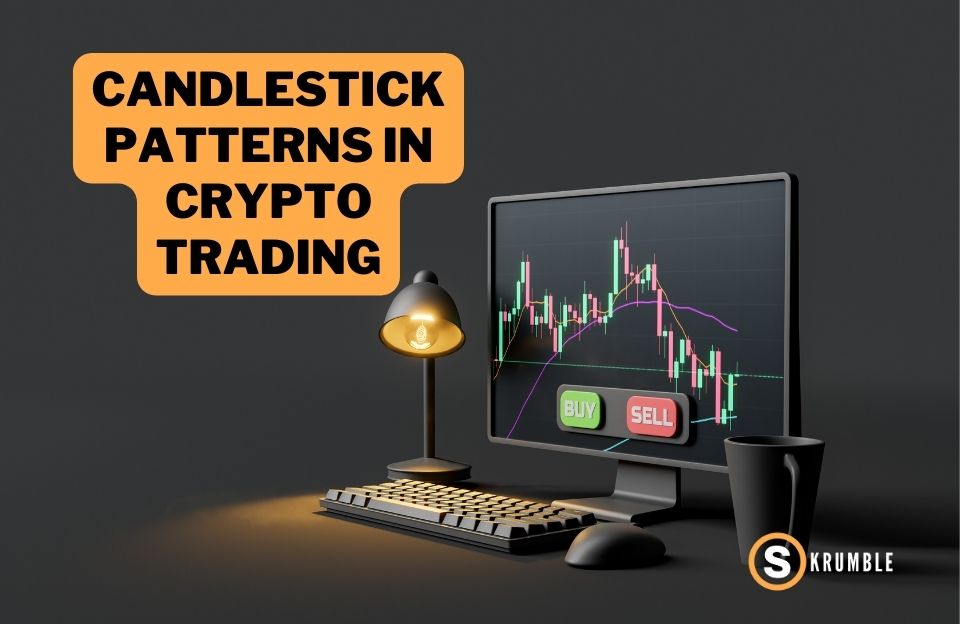- Home
- /
- Guides
- /
- Intermediate
- /
- Best Crypto Trading Strategies...
Best Crypto Trading Strategies for 2024: How They Work and Why You Should Use Them
Swen Keller

A crypto trading strategy is a systematic and methodological plan that traders and investors use to make informed decisions about buying, selling, or holding cryptocurrency assets, depending on the ongoing market conditions. It also serves as a roadmap, helping traders maximize their chances of profitability and minimizing the risks.
With the emergence of cryptocurrencies as a new financial sector, cryptocurrency trading has also gained significant popularity among professional traders and seasoned investors alike. However, the crypto market is dynamic, fast-moving, and evolving rapidly. As a result, a thorough understanding of crypto trading and a well-planned trading strategy is necessary for both professional and novice traders.
What is Crypto Trading?

Crypto trading can be approached as both a short-term activity, where traders seek to profit from short-lived price movements, or as a long-term investment, holding onto assets for an extended period in anticipation of price appreciation. Simply put, crypto trading refers to the buying and selling of cryptocurrencies with the objective of making a profit.
Crypto traders can trade a wide variety of digital currencies, including Bitcoin, Ethereum, Cardano, XRP, Litecoin, and thousands of other altcoins. You can buy and sell these assets through cryptocurrency exchanges or CFD providers. In addition, the crypto market operates 24/7 and is accessible worldwide through the internet, enabling everyone to participate.
However, the interminable and constantly-changing nature of the crypto space makes this market very volatile. The market risk factor is much larger than in most other financial markets and asset classes. Hence, engaging in crypto trading without a solid trading strategy is akin to navigating a ship without a compass.
A well-defined cryptocurrency trading strategy provides discipline and structure, guiding traders to make informed and rational decisions that not only help them achieve long-term success but manage the risk factor as well.
The Best Crypto Trading Strategies You Need to Know

Traders and investors have multiple cryptocurrency trading strategies at their disposal, each with its own strengths and weaknesses. Choosing the right trading strategy depends on your short-term and long-term goals, market knowledge, investment portfolio, and market conditions. Following are some of the most common strategies for trading cryptocurrencies.
Fundamental Analysis Strategy
Fundamental analysis is one of the most important techniques used to evaluate the intrinsic value and potential of a certain crypto asset. Unlike trading strategies, such as technical analysis, that rely on market data and chart patterns, fundamental analysis focuses on the underlying factors of a crypto project that drive its market performance. The aim of this strategy is to assess the long-term prospects of trading in crypto assets.
Fundamental analysis involves the consideration of several key factors. The foremost concern here is to research the project’s founder and development team. This practice will give you an idea about the credibility and expertise of the individuals involved in the project or cryptocurrency.
The next step is to evaluate the technology used for the project with a critical eye. Here, traders compare the technology of the project under examination with that of its competitors. It helps in understanding the capabilities and limitations of the cryptocurrency project. Cryptocurrencies with more utility and better potential for real-world use cases generally perform better in terms of price over the long run.
Furthermore, market adoption and community support play an essential role in the fundamental analysis strategy. Traders look for indicators of widespread adoptions, such as recent collaborations and big-profile partnerships. The active support from users, developers, and the broader crypto space also plays a vital role in establishing the overall sentiment around the project.
On top of that, the regulatory environment is a significant factor considered in fundamental analysis. If a project is under strict federal scrutiny, crypto investors are less likely to invest, and institutions tend not to adopt it altogether.
Fundamental analysis is generally used by investors and traders who wish to have a long-term perspective on the market. Such participants tend to hold their crypto funds for extended periods. Moreover, it also helps you to discover undervalued projects that show strong potential to grow and enjoy price surges in the near future.
However, it is important to note that a fundamental analysis strategy can involve the subjective judgment of qualitative factors. As a result, different analysts may reach different conclusions.
Technical Analysis Strategy

Technical analysts believe that past market behavior can provide valuable insights which can be used to predict the future direction of price trends. These strategists use a wide range of tools, including price chart patterns, historical price data, and technical indicators.
The primary purpose of adopting the this strategy is to predict the likely price movements and identify potential entry and exit points. The strategy can be used on different timeframes, and the results are applicable for short to medium-term trades.
First step

Traders analyze the ongoing trend of the price action, which can either be upward (bullish), downward (bearish), or sideways (neutral). Recognizing trends is the first step in deciding whether to buy, sell, or wait for a more favorable market condition. After that, the strategy focuses on identifying support and resistance levels. Resistance levels indicate price levels where selling pressure exceeds and the price struggles to move further up.
On the other hand, support levels are the price levels where the market experiences an inflow of cash, and the prices bounce up on the chart.
Such a trading style involves using a wide variety of technical indicators that provide deeper insights into market trends. Following are some of the most commonly used technical analysis tools.
Moving Averages (MA)
Moving averages are used to smooth out price data and identify trends in simpler and clearer terms.
RSI (Relative Strength Index)
RSI measures the speed and change of price movements to figure out the overbought and oversold conditions.
Bollinger Bands
This indicator shows the market volatility and potential price breakouts in cryptocurrency markets.
MACD
MACD is used by traders to identify changes in price trends. It also helps in finding potential buy and sell points.
Fibonacci Retracement
This indicator helps traders find out potential support and resistance levels based on the Fibonacci ratios.
The biggest benefit of a technical analysis strategy lies in its objective approach. By completely relying on historical data and objective indicators, you can minimize the chances of taking impulsive and emotional decisions. The strategy provides valuable insights into short to medium-term trades, making it suitable for active traders.
However, technical analysis strategies do not consider some of the most important market factors, such as market sentiment and real-time market use, all of which have a significant impact on how the cryptocurrency market behaves.
Crypto Day Trading Strategies

Crypto day trading (also called intraday trading) is a short-term trading strategy in which a crypto trader opens and closes a short-term trading position, often within the same trading day. Unlike long-term investors who hold their crypto assets for months and even years, active day traders seek to profit from intraday price movements.
Thanks to the volatile nature of the crypto markets, where prices fluctuate considerably within a day, intraday trading is much more popular in this space compared to other financial markets.
As they involve executing multiple trades within a single day, crypto day trading strategies require constant monitoring of the charts and quick decision-making. These traders often use leverage to amplify their potential gains, but this also increases the risk of potential losses.
Unlike other trading strategies where traders look out for stable cryptocurrencies with a big market cap, day trading cryptocurrencies are more profitable with a relatively liquid digital currency and substantial trading volume.
Moreover, the use of risk management techniques to protect your funds from major losses is a crucial element of a successful crypto day trading strategy. Most importantly, risk management involves setting stop-loss orders to limit potential losses in case of an unexpected price movements. Day traders are also advised to manage the size of every trade smartly.
Putting all your capital in a single trade can be risky, even leading to substantial losses in some cases. Finally, discipline is another critical component of day trading strategies. Following a well-defined trading plan and sticking to it can prevent you from overtrading and making impulsive decisions.
However, there are several challenges associated with any day trading cryptocurrency strategy. Day trading crypto usually requires traders to spend a significant time in constantly observing the market. This factor, combined with the fast-paced nature of day trading, can induce emotional stress.
Keep in mind frequent trades can lead to higher trading costs. Finding a crypto exchange with low trading fees can help in resolving this issue.
Swing Trading Strategy
In a swing trading strategy, crypto traders aim to capitalize on “price swings” with respect to an overall cryptocurrency market trend. Unlike day trading, swing traders hold their positions for several days to weeks. This approach allows them to take advantage of short price bumps, as well as broader upward market trends.
Such strategy is suitable for traders who want to be more actively involved in the market than long-term investors but prefer a less intensive strategy than intraday trading. This strategy also allows market participants to trade cryptocurrency with flexible time commitments.
Swing trading involves the use of support and resistance levels, moving averages, candlestick analysis, and some basic-level trading indicators. The first step is to identify the broader and shorter price trends. The next step is to draw out different support and resistance levels.
Ideally, traders prefer to start trading by buying when the price is near support levels and selling when the price reaches the resistance zone. Analyzing the candlestick patterns on the price charts is also a necessary step in swing trading, as it can help in predicting potential price reversals. Swing traders also utilize some primary technical tools, like moving averages and RSI.
Swing traders can benefit from the overall crypto market fluctuations, as prices can significantly increase over the course of a few weeks during a bull market. However, the same factor can prove to be a major drawback, and prices can drop substantially relatively quickly, leading to significant losses if the strategy is not executed well.
Moreover, maintaining emotional discipline is also important to avoid impulsive buys or sells. Making trades based on short-term price breaks can lead to losses while following this cryptocurrency trading strategy.
HODLing as a Trading Strategy

HODL is an acronym commonly used in the cryptocurrency space and stands for “hold on for dear life”. It refers to a long-term investment strategy in which participants buy and hold digital currency assets for extended periods, often years, without caring about short-term price fluctuations.
This strategy is based on the belief that established cryptocurrencies, such as Bitcoin and Ethereum, increase in value significantly over the years as a result of widespread adoption and technical developments. In other words, HODLers have faith in the future of these cryptocurrencies and view the short-term cryptocurrency market volatility as mere noise in the broader trend.
The HODLing approach involves little-to-no active trading. These traders typically wait for a bear market and accumulate assets when prices are relatively low. Then they wait months to years for a bull market and sell their cryptocurrencies at a significantly higher price.
HODLers resist the temptation of “FOMO” (Fear of Missing Out) during short-term price breaks and “FUD” (Fear, Uncertainty, and Doubt) during insignificant price dips. Both these phenomena are often the cause of impulsive decisions when it comes to beginners.
Advanced traders also incorporate dollar cost averaging (DCA) with their HOLDing strategy. DCA involves investing in a fixed amount of money (out of your total investment budget) at regular intervals, regardless of the asset’s price or market conditions.
This approach for making big investments for an extended period can potentially lead to a lower average purchase price. And dollar cost averaging helps HODLers mitigate the impact of short-term fluctuations.
Arbitrage Crypto Trading Strategies

Crypto arbitrage trading is a unique way of trading cryptocurrency assets that takes advantage of price disparities or the same asset across different exchanges or markets. Arbitrage traders seek to capitalize on price variations due to differences in demand, supply, trading volumes, or exchange inefficiencies on these platforms.
Arbitrage opportunities arise when a crypto token is priced differently on two separate exchanges. Traders can buy it at a lower price from one exchange and sell it for a higher price on the other one.
Arbitrage trading strategies have four main types:
Traditional Arbitrage
Traditional arbitrage trading means simply buying and selling the same crypto on different trading platforms that may experience price differences due to efficiency or delayed processing.
Spatial Arbitrage
Spatial arbitrage opportunities occur when an asset is priced differently in two different geographical regions or locations.
Temporal Arbitrage
Temporal arbitrage trading is done by exploiting the price variations that occur due to time zone differences.
Statistical Arbitrage
This type of arbitrage trading is undertaken by using advanced statistical algorithms that identify mispriced assets and execute trades instantly.
If executed successfully, arbitrage trading can yield significant profits within a very short period. However, these opportunities are often short-lived and may last barely a few seconds. The intense competition in the market due to the presence of a large number of traders also makes it more difficult to execute lucrative arbitrage trades.
Also, as the underlying technology for trading platforms improves, latency and delays are on the decline, leading to fewer opportunities for arbitrage traders.
Conclusion

Successful crypto trading often involves some level of market analysis, technical analysis, studying past price movements and patterns, or fundamental analysis, evaluating the underlying value and potential of the cryptocurrency. A thorough understanding of different trading strategies is, thus, essential in the dynamic and rapidly-moving cryptocurrency trading market.
Each strategy comes with its own strengths, weaknesses, and risk considerations. Traders must carefully evaluate their goals, risk tolerance, and time commitment to select the right trading strategy that works for them. Some strategies are good for beginners, while others are more suited for advanced traders.
Moreover, several investors also combine various crypto trading strategies to come up with a more flexible hybrid strategy. However, regardless of the trading strategy you use, it is important to remember that crypto is a highly-volatile market, and the risk factor is always higher when compared to traditional financial sectors.

FAQ
Most frequent questions and answers
Beginners are advised to invest only in lower-risk assets with better fundamentals for longer periods. Moreover, adapting strategies like DCA can also help decrease the overall loss potential.
Ideally, an intraday trader wants to trade cryptocurrencies that fluctuate substantially throughout the day and have a high trading volume. Altcoins, including XRP, FTM, SOL, DOT, and BNB, can be suitable for day trading.
Automated crypto trading bots can be highly profitable if executed well. Such bots are designed with automation, prediction, and execution technologies. The success rates vary from one bot to the other.
A successful crypto trader avoids impulsive decisions and never invests without proper research. Moreover, traders are advised never to invest more than they can afford to lose.
Skrumble.com provides all its content for informational purposes only, and this should not be taken as financial advice to buy, trade, or sell any investment instruments or products, including but not limited to cryptocurrencies, or use any specific exchange. Please do not use this website as investment advice, financial advice, or legal advice, and each individual’s needs may vary from that of the author. Investing in financial instruments, including cryptocurrencies, carries a high risk and is not suitable for all investors. It is possible to lose the entire initial investment, so do not invest what you cannot afford to lose. We strongly advise conducting your own research before making any investment decisions. This post includes affiliate links with our partners who may compensate us.
To view our privacy policy read here.






